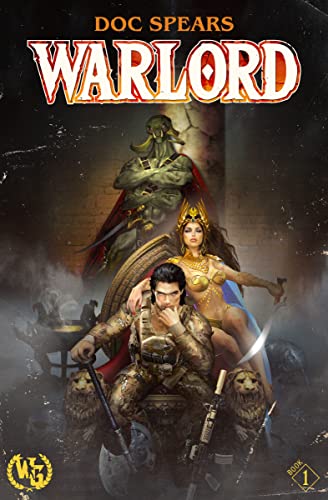 When aliens and a technoplague speed up the breakdown of technological civilization, the U. S. Government sends its best and brightest warriors into the future via portal technology. Once there, these warriors are to rally what remains of humanity and reform the United States.
When aliens and a technoplague speed up the breakdown of technological civilization, the U. S. Government sends its best and brightest warriors into the future via portal technology. Once there, these warriors are to rally what remains of humanity and reform the United States.
Army Special Forces sergeant Benjamin Colt’s team never arrive at the future. Instead, his Green Berets find themselves on a dying red planet, surrounded by fierce green natives, white apes, and red humans, all vying for survival.
Welcome to Mars.
Soon, Colt’s team is no longer his own, as half of it strips Colt of leadership and join with the barbarian hordes to set themselves up as the new kings of Mars. And grenades, machine guns, and missiles make for mighty force multipliers. Anyone who objects, like Colt, gets stranded in the Martian wastelands.
Now, to get his revenge–and save the humans of Mars–Colt must rally the remaining humans and their allies. He must become the Warlord of Mars.
Doc Spears tries his hand at uniting the military science fiction genre with Burroughsian sword and planet in Warlord: A Green Beret Conquers Mars. And once Spears gets to the Barsoom pastiche, the brakes are off.
Getting to Mars, however, is slow. Whereas the Martian adventure takes cues from A Princess of Mars, the Earthside preshow takes influences from John Ringo’s logistics science fiction books and Richard Marcinko’s Rogue Warrior. It is a blend of heavy worldbuilding, bragging, and confessional that is out of place for a pulp pastiche, but the bedrock of current military science fiction.
To be fair, some things need to be explained before Colt’s doomed flight into the future. This is a Wargate book, after all, one of a series of similar military fantasies with a common setup. Some malady is destroying civilization and so unreliable technology is used to send warriors escorting a miraculous molecular forge into the future to restart civilization. Disaster ensues, and the fight is on in the new world, whether that new world is patterned off of Norse mythology, Dungeons and Dragons, or Barsoom.
In Warlord, considerable time is placed on the molecular forge’s miraculous abilities, as Colt and his Special Forces comrades will spend considerable time fighting each other over for the forge’s spoils. Guns, bullets, beans, armor, and even nerve gas. The forge can make it all. And the timelost soldiers use it all, bringing the horrors of war to a planet unused to any strife deadlier than a night raid. In today’s current fashion, all that magic must be explained before the fun can start.
Also, Colt needs his time under the magnifying glass. Warlord is a dark shadow of Nick Cole and Jason Anspach’s Forgotten Ruin. Both deal with elite troops fighting for survival in a fantasy hellscape. But where the Ruin focus on the mindset needed to fight within the social structure provided by the U. S. Army Rangers, Warlord examines why and how elite soldiers fight when the structure of flag, anthem, and family is permanently removed, and no one has to play nice anymore. For that, Colt needs a reason, and enough psychological damage to explain why he casts everything aside to chase after a space princess.
Home life in the military, after all, is rarely happy–or even home at all. And Colt’s scars from the homefront run deep.
The result of all this setup is a first fifth of the book that feels like chugging up a rollercoaster lift hill. And then Kraal Kahless’s green Tarns attack the SF team from ambush, and the ride begins.
What follows is a whirlwind of rifles, rayguns, and romance, spurred on by backstabbing and betrayal among the Special Forces team. Some, such as Colt and his friends, cling to Earth and Special Forces values. Others strike out for any advantage they can claim, even if it means tyrannizing a new world in the process. Contemplation and exposition are traded for action and struggle.
The plot and setting fill the familiar banks carved out by Edgar Rice Burroughs in A Princess of Mars, properly renamed, of course. Spears is writing a pastiche of Burroughs, and not an unauthorized sequel to Barsoom, as tradpub is wont to do with Little Fuzzy and Captain Future. Spears’ Vistara pays homage to Burroughs and Barsoom without resorting to cheap imitation. And it is a welcome sight to see feats of strength and endurance return to adventure stories, instead of relying solely on feats of arms.
Very pulpy. But also unlike what came before. Fortunately, as I read the sequel, Warlord of the Nightmare Realm, the action continues at this pace. Perhaps Spears has managed to shrink a Ringo logistics phase from one book to much less than that. But the integration of world details and adventure, genre-wide, needs more work.
That said, a pulp pastiche of Barsoom is one of those ideas as a PulpRev guy that makes me slap my forehead and wonder why I never thought of the idea. And, Spears does the idea–and those he served with–honor with this tale.
Please give us your valuable comment